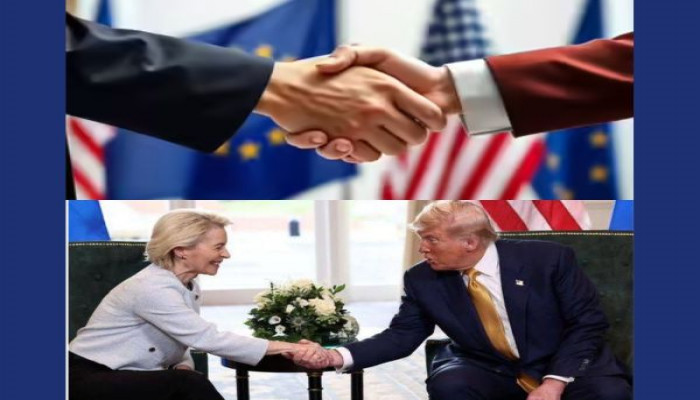US and EU seal trade deal with 15% tariff, avoid major trade war
- In Reports
- 04:41 PM, Jul 28, 2025
- Myind Staff
The United States and the European Union reached a framework trade agreement on Sunday, imposing a 15% tariff on most EU goods, which was half the initial rate threatened, preventing a broader trade conflict between the two allies that accounted for nearly one-third of global trade.
U.S. President Donald Trump and European Commission President Ursula von der Leyen announced the deal at Trump's exclusive golf course in western Scotland after an hour-long meeting that finalised the hard-fought agreement following months of discussions.
"I think it's the greatest deal ever made," Trump said, praising EU plans to invest about $600 billion in the United States and to significantly increase its imports of U.S. energy and defence equipment.
The deal, which surpassed a $550 billion agreement with Japan last week, would strengthen ties between the transatlantic powers after years of what he called discriminatory treatment of U.S. exporters.
Von der Leyen, describing Trump as a tough negotiator, said the 15% tariff applied "across the board," and later told reporters it was "the best we could get."
"We have a trade deal between the two biggest economies in the world, and it's a big deal. It's an enormous deal. It will bring stability. It will bring predictability," she said.
The agreement reflected the main aspects of the framework deal reached by the United States with Japan, but like that deal, it left some questions unresolved, including tariff rates on spirits, which remained a contentious issue for many on both sides of the Atlantic.
Trump said the deal included $750 billion of EU purchases of U.S. energy in the coming years and "hundreds of billions of dollars" of arms purchases, which was likely to benefit EU companies such as Airbus, Mercedes-Benz and Novo Nordisk if all details were finalised.
German Chancellor Friedrich Merz welcomed the deal, saying it avoided a trade conflict that would have hurt Germany's export-driven economy and its large automobile industry. German carmakers, including VW, Mercedes and BMW were among the hardest hit by the existing 27.5% U.S. tariff on car and component imports.
The 15% tariff was still considered too high by many in Europe compared with the bloc's initial hopes for a zero-for-zero tariff agreement.
Bernd Lange, the German Social Democrat who headed the European Parliament's trade committee, said the tariffs were unbalanced and that the significant EU investment planned for the United States would likely come at the bloc's expense.
A senior U.S. administration official told reporters on Sunday evening that Trump retained the authority to raise tariffs in the future if European nations failed to meet their investment commitments.
The euro rose around 0.2% against the dollar, pound and yen within an hour after the deal was announced.
Carsten Nickel, deputy director of research at Teneo, said the deal was "only a high-level, political agreement" that could not replace a detailed and thoroughly negotiated trade pact, adding that "This then provides the risk of varying interpretations along the way, as witnessed right after the U.S.-Japan agreement."
Although the tariff applied to most products, including semiconductors and medicines, some goods were exempted.
The United States kept a 50% tariff on steel and aluminium. Von der Leyen suggested replacing this with a quota system, while a senior U.S. official said EU leaders requested that both sides continue negotiations on the issue.
Von der Leyen said there would be no tariffs on either side for aircraft and aircraft parts, certain chemicals, generic medicines, semiconductor machinery, some agricultural goods, natural materials and critical raw materials.
"We will continue to add products to the list," von der Leyen said, noting that spirits were still under negotiation.
A U.S. official said the tariff on commercial aircraft would remain zero for now, and both sides would decide later after a U.S. review was completed, adding there was a "reasonably good chance" they might agree to a lower rate than 15%. No timeline was given for completing the review.
The agreement was seen as a major victory for Trump, who aimed to reshape the global economy and reduce long-standing U.S. trade deficits, and had already reached similar framework deals with Britain, Japan, Indonesia and Vietnam, though his administration had not achieved its target of "90 deals in 90 days."
U.S. officials said the EU had agreed to reduce non-tariff barriers for automobiles and certain agricultural products, while EU officials said the details of those standards were still being discussed.
"Remember that their economy is $20 trillion. they are five times larger than Japan," a senior U.S. official said during a briefing. "So the prospect of opening their market is tremendous for our farmers, our fishermen, our ranchers, all our industrial goods, all our business."
Trump had repeatedly criticised the EU, saying it was "formed to screw the United States" on trade. He had long complained about the U.S. merchandise trade deficit with the EU, which in 2024 reached $235 billion according to U.S. Census Bureau data.
The EU pointed to the U.S. surplus in services, which it said partially offset the imbalance.
Trump maintained that his tariffs were bringing in "hundreds of billions of dollars" for the United States while dismissing warnings from economists about inflation risks.
On July 12, Trump had threatened to impose a 30% tariff on EU imports starting August 1, after weeks of unsuccessful negotiations toward a comprehensive trade agreement. The EU had prepared counter tariffs on goods worth 93 billion euros or $109 billion from the United States in case an agreement could not be reached.







Comments